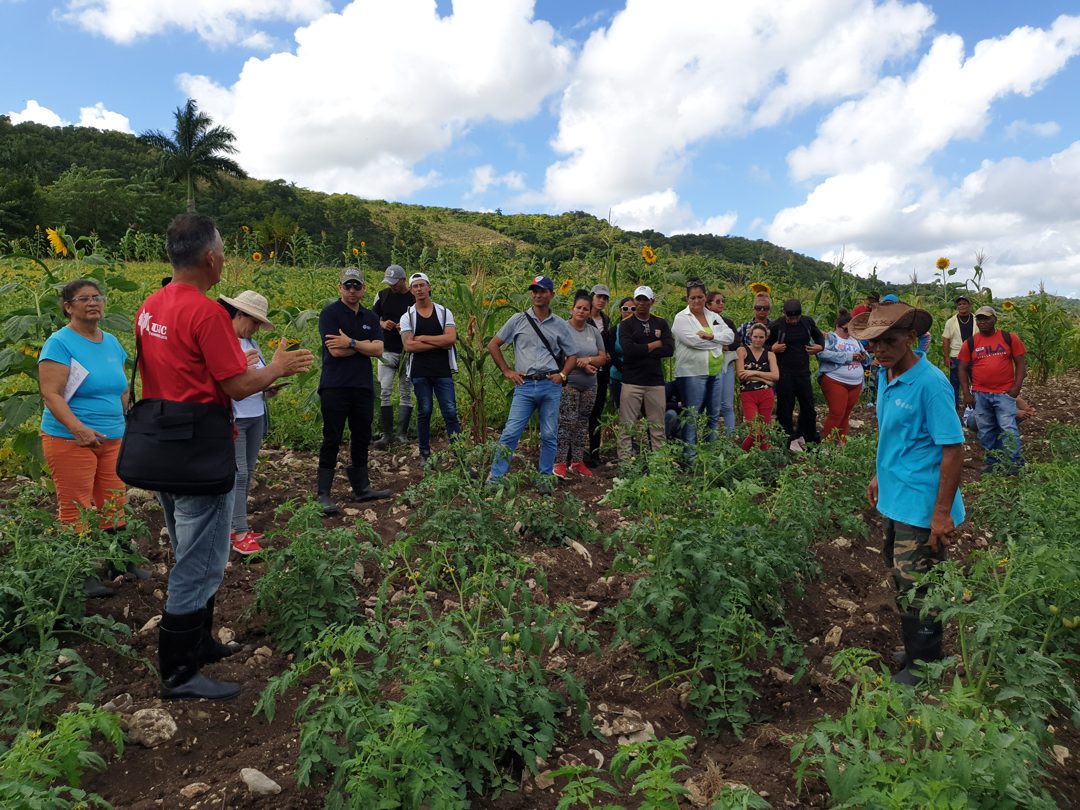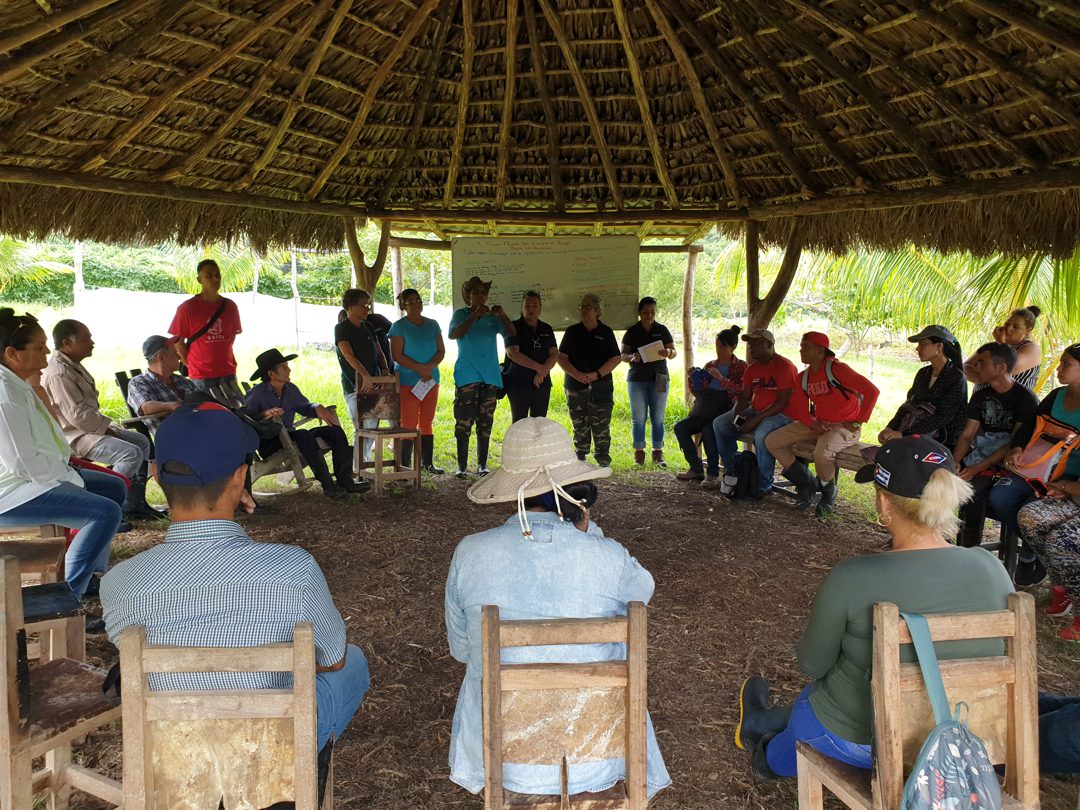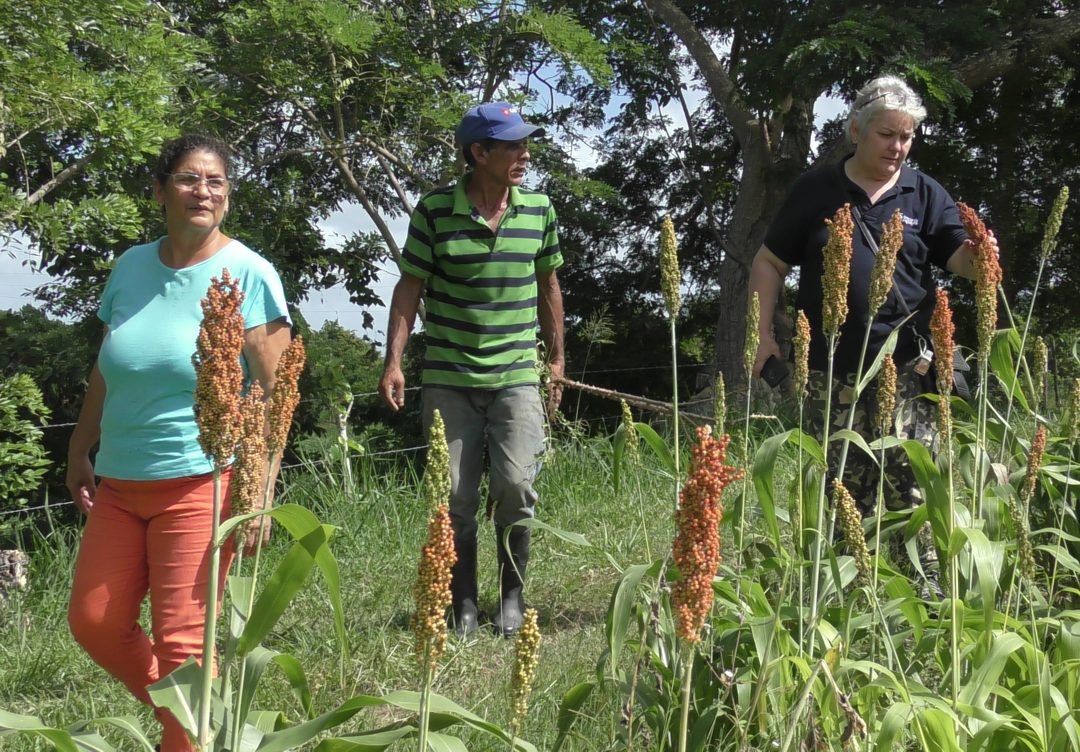
Because in the era of new information and communication technologies, the word connection immediately refers to events in cyberspace, the title might seem mocking, considering that the report focuses on an area with weak radio-electronic signals.
Those who have "embraced" the central column of the portal of the home of Osveldo Gómez Reina and Ana Elsy Guerra Galafert, or following other family recommendations, sat on the patio, in the shade of the almond tree, to "fish” the coverage that allows, at least, to make a call or post on social networks.
However, other links are strong in the Rincón de Mabuya, at the foot of the section of the Bamburanao mountain range belonging to the municipality of Chambas, in the northwest of the province of Ciego de Ávila, where the integration between the hills and the productive areas is a fait accompli after eight years of the international project Connecting Landscapes.
Rincón Los Hondones: the “switch”
Like a switch, a device that serves to interconnect all the equipment in a network, the Farm School with Landscape Focus Rincón Los Hondones, at the foot of the elevations that cross the Chambas territory, managed to link most of the producers in the area in the effort to implement environmentally friendly agricultural practices.
María del Carmen Olivera Isern, sub-delegate for the Environment and coordinator of this global program in Ciego de Ávila, expressed that this productive unit stood out at the national level as the one with the best results in meeting the objectives of the project.
She explained that the producers Osveldo and Ana Elsy, linked as professors to the Chambas Municipal University Center (CUM), unleashed a local movement by sharing knowledge about agro-ecological practices, and the management of natural resources (soils, water and plants), which favors adaptation to climate change.
In the 3.21 hectares of Rincón Los Hondones, they demonstrate the ability to be self-sufficient and contribute to social consumption, reduce dependence on the environment and external inputs in agricultural production, and promote the consumption of healthy foods, she stressed.
She highlighted the use of efficient microorganisms to decompose organic matter and increase the availability of nutrients in the soil, inhibit the growth and development of harmful species, stimulate the evolution of crops, degrade toxic substances and improve the quality of the land.
She pointed out other techniques such as planting in contours on contour lines to reduce the erosive incidence due to climate change in the highlands and the eradication of the tendencies to the formation of gullies by forming dams with stones.
Other methods such as polyculture and intercropping, the application of organic matter and harvest waste to the land, the incorporation of repellent plants to dissociate pests and the development of evacuation ditches to prevent rainwater currents from deteriorating the soil are added to this.
They use animal traction and soil conservation implements and living fences; in addition to diversifying crops and incorporating animal husbandry, she added.
These procedures benefit the agroecosystem and its conservation; allow optimal use of space and the recovery of forest and fruit populations, with good yields and quality in productions for consumption.
In this way, they establish connectivity between the mountainous ecosystem and the productive zones, which favors the protection of the environment and increases biodiversity, she emphasized.
She considered that the results reward the efforts of Connecting Landscapes by creating human and material capacities for the development of sustainable productions in this area.
Olivera Isern also appreciated the contribution of the Ranger Corps in intensifying actions to control forest fires.
She thanked the CUM students and professors for joining the farm, the latter with the merit of transferring agro-ecological practices in the mountains to the town of Punta Alegre, site of direct intervention of the international Coastal Resilience project.
Besides, she affirmed that Connecting Landscapes ends, but the experiences remain, the commitment to continue the transfer of knowledge and the links with the house of higher studies.
Ofelia Roca García, a professor at the CUM in Chambas, announced that this farm-school will soon become the new teaching unit of the Máximo Gómez Báez University, in Ciego de Ávila, so that students from the central campus will also carry out internships at the place.
She specified that Rincón Los Hondones also contribute to the training of two CUM professors in the specialty of Local Agricultural Innovation Systems.
Ney Díaz Alemán, second-year student of the Agronomy career and member of the Municipal Secretariat of the Federation of Cuban Women in Chambas, underlined that Rincón Los Hondones achieves greater motivation and linkage of the female sex to the study of the Agronomy career and the tasks in the countryside.
Beirys Rodríguez Venegas, producer of the Máximo Gómez Credit and Services Cooperative, from the territory, acknowledges that the stays on the farm allowed her to verify the effectiveness and benefits of organic fertilizers.
Yoandys Pérez, a third-year Agronomy student at CUM, appreciated the opportunity to carry out work practices and research on the farm, activities that allow her to combine theoretical and practical knowledge on soil management, pest control and intercropping.
In Ciego de Ávila properties, Connecting Landscapes has also benefited producers from three forest farms (El Cuchillo, II Congreso and Los Ramones), in the municipality of Florencia; and another of medicinal plants in the territory of Chambas.
Connecting Landscapes, ssponsored by the United Nations Development Program, the Forest Business Group, and the Ministries of Agriculture and Science, Technology and Environment, has guaranteed the effective protection of biodiversity against current and future threats in mountain landscapes.
In addition to provide knowledge, it conceives the improvement of the living and working conditions of the people who inhabit these ecosystems, who benefit from deliveries of work tools, clothing for work in the fields, and household items.

The culmination of the environmental management actions foreseen by the international project in four mountainous massifs of the country (Guaniguanico, Guamuhaya, Bamburanao and Nipe-Sagua-Baracoa), favors decision-making for the sustainable management of these areas.
In these special regions of sustainable development, the work included updating maps and the status of protected areas; the latter increased by nine as a result of the studies, Lázara Sotolongo Molina, project director, reported.
She explained as other achievements the reforestation of hydrographic basins, conservation of floristic resources, creation of agroforestry and silvo-pastoral farms, and the preparation of three bio-digesters that will supply energy (biogas) to a community and a primary school, therefore, they contribute to the development local.
She said that in recent years in these mountainous regions forest cover has been maintained and landscape fragmentation has decreased as there is greater movement of species as a result of connectivity, favorable for conserving biological diversity.
Likewise, the farms linked to the project have contributed to the Food Sovereignty and Nutrition Education Program, by supplying food to communities and social institutions, which confirms the economic and social impact of Connecting Landscapes.






